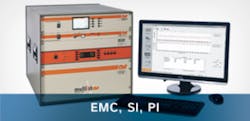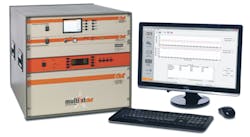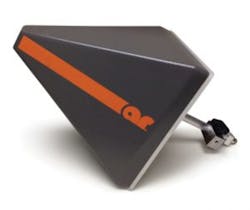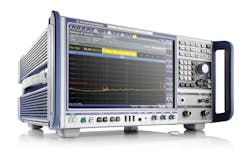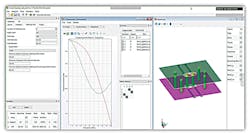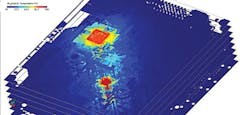As more and more devices proliferate and make use of limited spectrum, issues related to electromagnetic compatibility become critical. Electrical and electronics engineers designing everything from military/aerospace systems to IoT edge devices must contend with EMC, signal integrity (SI), and power integrity (PI).
The 2017 IEEE International Symposium on Electromagnetic Compatibility, Signal Integrity, and Power Integrity (EMC+SIPI), to be held Aug. 7-11 near Washington, D.C., will provide a venue for learning about the latest in EMC, SI, and PI technology and seeing demonstrations of products that can help you achieve high-performance designs that comply with relevant standards.
Technical topics at the symposium will include EMC measurement, EMI control, EMC management, computational electromagnetics, high-power electromagnetics, and electromagnetic environments. Three “theme topics” include “EMC for Emerging Technologies” (including wireless devices, the smart grid, nanomaterials and silicon photonics, and unmanned aircraft systems), “Signal and Power Integrity” (covering high-speed channel characterization and modeling, co-design and co-simulation; 3D packaging; and jitter, BER, and equalization measurement techniques), and “EMC and the Internet of Things” (addressing RF spectrum challenges, medical devices, smart cities, energy, and next-generation device and system requirements). In addition, Julius Knapp, who has been with the FCC for 42 years and has served as the chief of the FCC’s Office of Engineering and Technology since 2006, will deliver a keynote address titled “Achieving EMC in an Everything Wireless World.”1
In addition, show organizers report that more than 200 vendors will exhibit offerings including test equipment and accessories; EMI mitigation products; and EMC, SI, and PI modeling software. Several test-and-measurement companies have previewed their plans for the show.
Joe DiBiase, manager of EMC applications and systems at AR RF/Microwave Instrumentation, outlined his vision for the event. “At the core of AR is a belief that EMC testing plays a major role in successful and safe product deployment and product life,” he said. “With that in mind, AR has developed EMC products that produce state-of-the-art performance to achieve the highest quality, most efficient, and most accurate test results. The MT06002 multi-tone tester system emphasizes this point by combining the latest hardware and software designs, offering test labs significant reductions in test times while maintaining the highest quality of test results and adhering to the various standards requirements.” The MT06002 (Figure 1), he said, provides extended frequency ranges and high testing efficiencies for automotive and other applications.
Courtesy of AR RF/Microwave Instrumentation
In addition to the MT06002, he said, the company will highlight new solid-state pulse amplifiers added to the company’s line of products for automotive, MIL-STD-464, and DO-160 applications as well as the new low-power, cost-reduced Universal Series (U) solid-state amplifiers.
The company also will highlight its latest antenna offering—the AT700M12G wideband trapezoidal log-periodic antenna (Figure 2), which operates from 700 MHz to 11 GHz. DiBiase continued, “Our revolutionary AA18G26 and AA26G40 field generator systems will be capable of producing 30 V/m in both the 18- to 26.5-GHz and 26.5- to 40-GHz band and will be a fitting replacement for current TWTA designs.” Finally, he said, the company’s newest division, SunAR RF Motion, will highlight products such as its EMI test antennas and antenna-positioning equipment.
Courtesy of AR RF/Microwave Instrumentation
AR will be participating in the symposium’s technical program with AR applications engineer Flynn Lawrence presenting “The Future of Immunity Testing.” DiBiase said, “This paper provides an overview of current radiated and conducted immunity test approaches and [describes] how these tests can be improved using multi-tone and complex waveform test approaches to more closely replicate real-world threats.”
Addressing the development cycle
According to Rohde & Schwarz marketing manager Faride Akretch, the company offers the full range of products for EMC test, including receivers, amplifiers, antennae, chambers, and complete automated test systems. “Furthermore, we provide solutions for the entire development cycle.” he said.
At the show, Rohde & Schwarz will present oscilloscopes and spectrum analyzers for EMI debug at the development and design-verification phase as well as receivers, amplifiers, and systems for precompliance and full-compliance test. Highlights will include the ESW EMI test receiver (Figure 3), which offers a frequency range from 2 Hz to 44 GHz and meets the requirements for certification measurements in line with CISPR, EN, MIL‑STD-461, DO‑160, and FCC standards. “With its FFT-based time-domain scan, the R&S ESW captures and weights disturbance spectra in virtually no time,” Akretch said. “The instrument’s real-time spectrum analysis capability with 80-MHz bandwidth … and spectrogram function permits a detailed analysis of disturbance signals and their history.”
Courtesy of Rohde & Schwarz
Also on display, he said, will be the R&S BBA150 and BBL200 broadband amplifier families. The compact BBA150 generates power in the 9-kHz to 6-GHz frequency range and is suitable for amplitude, frequency, phase, and pulse modulation. It offers extensive switching options for input, output, and sample ports. The R&S BBL200 serves applications requiring up to 10 kW of power in the 9-kHz to 225-MHz frequency range. “They are liquid-cooled, solid-state, highly rugged, quiet, and efficient,” he said. “Precise monitoring of all runtime parameters ensures maximum robustness and reliability.”
Rohde & Schwarz also will offer a technical presentation titled “Improving Pulsed/Intermittent Signal Measurements Utilizing Time Domain Scan and Real-Time Spectrum Analysis.” Akretch explained, “The growing complexity of electronics within both military and commercial products is resulting in the emissions of more pulsed/intermittent signals, which must be properly characterized during EMC testing. Unfortunately pulsed and/or intermittent signals are difficult to detect and even more difficult to properly characterize for electromagnetic interference.”
He added that a pulse signal’s measured parameters are a direct result of the measurement parameter settings and test receiver architecture. “There are several methods to perform the task of measuring the electromagnetic (conducted or radiated) emissions of a pulsed signal,” he said. “A thorough understanding of the method of measurements for each is necessary to assess the strengths and weaknesses.” The presentation will describe three EMC test methodologies: frequency swept, frequency stepped, and time-domain scan. “We will demonstrate the details of each for a pulsed signal stimulus and provide insight for best measurement techniques for each method,” he said.
EMI troubleshooting
Tektronix will exhibit a range of products that support EMI troubleshooting and precompliance test, addressing challenges related to conducted and radiated emissions, according to Wilson Lee, technical marketing manager. Of particular note, he said, “Our brand-new 5 Series MSO launched June 2017 brings innovations and unprecedented flexibility to our design engineer customers.”
The new scope (Figure 4) includes reconfigurable channels, called FlexChannels, that can accept either analog or digital inputs. Each FlexChannel input can be used as one analog input channel or eight digital probe channels.
Courtesy of Tektronix
“In parallel, our new 5 Series scope will be the only scope of its kind to offer four-, six-, and eight-channel configurations,” he said, adding that the 5 Series MSO has the highest resolution capacitive-multitouch display of any oscilloscope on the market—at 15.6 inches diagonally, it offers a high-definition display with resolution of 1,920 horizontal pixels x 1,080 vertical pixels. “The direct-access user interface has been built from the ground up,” Lee said. “The product was designed to be driven solely by touch, with no hidden or nested menus. All it takes is a single or double tap to activate menus around the screen.”
To address signal-integrity issues, Tektronix offers an optional jitter and eye-analysis software package for 5 Series scopes. The company’s DPOJET functionality is integrated into the scope application to provide fast and intuitive operation. Users can access jitter measurements in the same manner as other 5 Series measurements. The application supports most common jitter measurements and creates the following views: bathtub plot, time-interval-error (TIE) histogram, TIE spectrum, and eye diagram.
Back to the frequency domain
Lee said that Tektronix also will exhibit its MDO4000C mixed-domain oscilloscope, which enables correlated measurements between time and frequency domains—functionality that’s applicable in areas of EMI troubleshooting and precompliance test. The MDO4000C combines up to six instruments, including a built-in, integrated spectrum analyzer and options such as a function generator.
The company will exhibit its RSA Series spectrum analyzers, which, Lee said, combine full-featured performance and versatility. They offer 40 MHz of bandwidth capture and a frequency range up to 7.5 GHz for a variety of lab or field applications. “Our RSA Series is powered by SignalVu software—enabling one user interface for RF and vector signal analysis across our real-time spectrum analyzers, USB spectrum analyzers, and our MDO4000C mixed-domain oscilloscope,” he said.
Siglent also will be highlighting spectrum analyzers at the show, according to Jason Chonko, applications marketing manager, Siglent Technologies America.
“We are exhibiting the SSA3000X Series spectrum analyzers with an optional EMI software tool kit, Siglent near-field probe kit, and the other EMC precompliance accessories that bring real troubleshooting tools within reach of every engineer,” he said. “The SSA line is designed to be easy to use and deliver excellent performance without breaking your budget. It has a 10-inch full-color LCD, four available traces, -161 dBm/Hz DANL, and an optional EMC software kit that can provide common EMC test settings (quasi-peak detector, FCC RBW bandwidths) to help identify and solve compliance problems quickly.”
He concluded, “For less than the cost of one trip to the compliance lab, you can outfit your lab with enough instrumentation to solve all but the most difficult EMC-related
challenges.”
For its part, Teledyne LeCroy will demonstrate how its oscilloscopes with custom software can perform EMC/ESD measurements. “The software provides fast and accurate EMC pulse verification with customizable rise, fall, and width parameters as well as the capability to histogram up to 2 billion events,” according to Hilary Lustig, marketing communications manager at the company.
“Understanding an electronic design’s susceptibility to electromagnetic (EM) discharge is an important element of validation,” she added. “Whether fast one-time transients or repetitive bursts, EM can introduce unexpected events in the circuit’s performance. Teledyne LeCroy oscilloscopes offer high sample rates and measurements tailored specifically to this task. Whether a single pulse or billions of measurements, engineers gain insight into their device and system susceptibility.”
She added, “Teledyne LeCroy oscilloscopes can uniquely set measurement thresholds to 0% and max as defined in the IEC 61000-4-2 specification”—a requirement in order to correctly measure the rise time, fall time, and pulse width of EMC pulses, resulting “… in a unique ability to characterize EMC pulses correctly per the standard specifications.”
As part of the technical program, she said, Teledyne LeCroy will present a paper entitled “Detection Methods for Secondary ESD Discharge During IEC 61000-4-2 Testing,” co-written with researchers from the Missouri University of Science and Technology.
Design and simulation software
Keysight Technologies will highlight its Advanced Design System (ADS) electronic design automation software for RF, microwave, and high-speed digital applications, according to Stephen Slater, signal and power integrity product manager. ADS 2017, he said, introduces Via Designer—a tool that can be used to quickly analyze via configurations and create parametrized EM models for use in schematic simulations (Figure 5). “The existing ADS Simulation Manager tool has been enhanced to support Windows, making batch and parallel simulations available to more designers, and using S-parameters with many ports will be made even faster,” he said. “Additionally, ADS 2017 features enhancements to PAM4 simulations, DDR bus simulations, simplified IBIS model usage, automated schematic wiring, and mixed-mode support for ADS S-parameter Checker.”
Courtesy of Keysight Technologies
Keysight also will be emphasizing PIPro, which Slater described as an EM solution available in ADS for power-integrity analysis—providing simulation engines for DC IR drop, power-distribution-network (PDN) impedance, and power-plane resonance analysis. “Typically, PCB designers perform PI checks to ensure the PDN provides sufficient voltage/current to the ICs on a PCB,” he said. “Tools like PIPro analyze the DC IR drop between the voltage regulator module and each IC. In ADS 2017, PIPro has been updated to include a new integrated electrothermal simulation feature that’s designed to improve the accuracy of the DC IR drop results by taking thermal effects into account.” PIPro also locates hot spots in the PCB design (Figure 6), he said. “This new capability helps designers detect PI-related thermal issues earlier in the PCB design process,” he said, adding, “ADS, PIPro, and the ADS solution for signal-integrity analysis, SIPro, provide the speed, performance, and functionality to address the breadth of EMC/EMI, SI, and PI challenges today’s designers face.”
Courtesy of Keysight Technologies
Slater cited as an example the SI challenges of quickly and accurately characterizing multigigabit data rate designs and measuring the margin-to-mask for really low bit-error-rates, as demanded by high-speed link designs. As for the solution, he said, “SIPro provides SI analysis of high-speed PCBs, enabling designers to characterize loss and coupling of signal nets and extract an EM-accurate model that can be used in the ADS transient and channel simulators. It delivers results approaching the accuracy of full-wave 3D-EM solutions, but in a fraction of the time.” ADS channel simulation, he added, facilitates computing BER contours, which are needed for measuring margin-to-mask easily.
As part of the technical program, Heidi Barnes, a senior applications engineer for Keysight EEsof EDA’s high-speed digital applications, will co-chair a tutorial titled “Signal and Power Integrity (SIPI) 2—High Speed SI Measurements.” “The tutorial will identify a methodology for characterizing high-speed interconnect at frequencies up to 50 GHz,” Slater said. “This methodology is being captured in the IEEE P370 standards development project. Specific topics to be covered during the tutorial include how to meet the electrical requirements of a proper test fixture, verify that a de-embedding tool correctly subtracts the fixture from the overall measured response, and verify the integrity of measured, de-embedded S-parameters before using them in end-to-end link models.”
He added that Barnes also is scheduled to present a paper titled “Design Considerations and Acceptance Criteria for Test Fixtures,” which will highlight things designers should consider when selecting test fixtures as well as the criteria that should be used for acceptance testing.
For more information on the 2017 IEEE International Symposium on Electromagnetic Compatibility, Signal Integrity, and Power Integrity, visit http://www.emc2017.emcss.org/. In addition, check the online version of this article for updates as the event nears.
Reference
Advance Program, 2017 IEEE International Symposium on Electromagnetic Compatibility, Signal Integrity, and Power Integrity.
For more information
About the Author

Rick Nelson
Contributing Editor
Rick is currently Contributing Technical Editor. He was Executive Editor for EE in 2011-2018. Previously he served on several publications, including EDN and Vision Systems Design, and has received awards for signed editorials from the American Society of Business Publication Editors. He began as a design engineer at General Electric and Litton Industries and earned a BSEE degree from Penn State.
